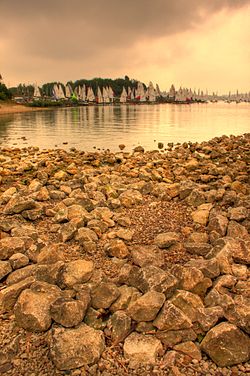Carsington Water
| Carsington Water | |
|---|---|
 A sailing regatta at Carsington Water. | |
 Carsington Water Location in Derbyshire | |
| Location | Derbyshire |
| Coordinates | 53°3′30″N 1°37′50″W / 53.05833°N 1.63056°W / 53.05833; -1.63056Coordinates: 53°3′30″N 1°37′50″W / 53.05833°N 1.63056°W / 53.05833; -1.63056 |
| Lake type | reservoir |
| Primary inflows | tunnel/aqueduct from River Derwent |
| Primary outflows | River Derwent |
Basin countries | United Kingdom |
| Managing agency | Severn Trent Water |
| Built | 1989 (1989) |
| First flooded | 1992 |
| Max. depth | 33 m (108 ft) |
| Water volume | 35,412 ML (28,709 acre⋅ft) |
| Surface elevation | 200 m (660 ft) |
| Islands | 2 islands, one opposite the Sailing Club, and the sailing centre. |
Carsington Water is a reservoir operated by Severn Trent Water located between Wirksworth and Kniveton in Derbyshire, England. The reservoir takes water from the River Derwent at Ambergate during winter months, pumping up to the reservoir by 10.5-kilometre (6.5 mi) long tunnels and aqueduct. Water is released back into the river during summer months for water abstraction and treatment further downstream. It is England's ninth largest reservoir with a capacity of 35,412 megalitres.[1]
Planning for the reservoir started in the 1960s with actual construction starting in 1979. In 1984 there was a partial collapse of the dam prior to its filling. The dam was subsequently completely removed before construction of a new dam commenced in 1989. The finished reservoir was opened by Queen Elizabeth II in 1992.[1]
The reservoir is a major centre for leisure activities including walking, cycling, fly fishing, birdwatching, sailing, canoeing, and windsurfing. The land surrounding the reservoir, in particular the facilities around the visitor centre, has played host to events including a music festival, the Festival of the Peak.
Contents
1 Facilities
2 Wildlife Discovery Room at Carsington Water
3 References
4 External links
Facilities
There are 3 main buildings on the Reservoir, that serve the public in a few different ways.
The Visitor Centre is the largest building, with a cafe featuring panoramic views. There is a small retail outlet currently leased by the RSPB and an outdoor equipment store.
Carsington Sports and Leisure is a place for the public to rent equipment, primarily bikes. The company also rents kayaks, canoes, small rowing boats,
sailing boats and windsurfing equipment. The company has a good stock of new windsurf hire equipment, with 3 quality starboard boards and sails from 3.5 to 7.5, with beginner kit also.
Carsington Sailing Club owns an extensive proportion of the shoreline. Members can hire boats, as well as store boats from small dinghies to anchored cruisers.
There are also smaller buildings erected by Severn Trent, namely the bird hide, north of the visitor centre on the circular bike route, as well as other more minor wildlife based-buildings dotted around the track.
There are three car parks situated by the reservoir, one main one at the site and a southerly one, Millfields that has smaller capacity and a northerly one, Sheepwash, which has a similar capacity.
Birds seen at the site include little owl, little grebe, great northern diver, Eurasian oystercatcher, common tern and breeding common redshank. Feral barnacle geese are found there; a wild, ringed, barnacle goose was found in March 2011—it was ringed at WWT Caerlaverock in Dumfrieshire, Scotland on 8 February 1999.
Fly fishing is available from boats that can be hired from the Fishing Lodge. Fly fishing is for brown trout and rainbow trout only.
Wildlife Discovery Room at Carsington Water
The Wildlife Discovery Room at Carsington Water is operated as a partnership of Derbyshire Wildlife Trust and Severn Trent Water. The Trust offers nature programs for schools, children and families.[2]
References
| Wikimedia Commons has media related to Carsington Water. |
^ ab "Carsington Report" (PDF). Sheffield Hallam University. Retrieved 22 Mar 2013..mw-parser-output cite.citation{font-style:inherit}.mw-parser-output .citation q{quotes:"""""""'""'"}.mw-parser-output .citation .cs1-lock-free a{background:url("//upload.wikimedia.org/wikipedia/commons/thumb/6/65/Lock-green.svg/9px-Lock-green.svg.png")no-repeat;background-position:right .1em center}.mw-parser-output .citation .cs1-lock-limited a,.mw-parser-output .citation .cs1-lock-registration a{background:url("//upload.wikimedia.org/wikipedia/commons/thumb/d/d6/Lock-gray-alt-2.svg/9px-Lock-gray-alt-2.svg.png")no-repeat;background-position:right .1em center}.mw-parser-output .citation .cs1-lock-subscription a{background:url("//upload.wikimedia.org/wikipedia/commons/thumb/a/aa/Lock-red-alt-2.svg/9px-Lock-red-alt-2.svg.png")no-repeat;background-position:right .1em center}.mw-parser-output .cs1-subscription,.mw-parser-output .cs1-registration{color:#555}.mw-parser-output .cs1-subscription span,.mw-parser-output .cs1-registration span{border-bottom:1px dotted;cursor:help}.mw-parser-output .cs1-ws-icon a{background:url("//upload.wikimedia.org/wikipedia/commons/thumb/4/4c/Wikisource-logo.svg/12px-Wikisource-logo.svg.png")no-repeat;background-position:right .1em center}.mw-parser-output code.cs1-code{color:inherit;background:inherit;border:inherit;padding:inherit}.mw-parser-output .cs1-hidden-error{display:none;font-size:100%}.mw-parser-output .cs1-visible-error{font-size:100%}.mw-parser-output .cs1-maint{display:none;color:#33aa33;margin-left:0.3em}.mw-parser-output .cs1-subscription,.mw-parser-output .cs1-registration,.mw-parser-output .cs1-format{font-size:95%}.mw-parser-output .cs1-kern-left,.mw-parser-output .cs1-kern-wl-left{padding-left:0.2em}.mw-parser-output .cs1-kern-right,.mw-parser-output .cs1-kern-wl-right{padding-right:0.2em}
[permanent dead link]
^ Wildlife Discovery Room
External links
Wildlife Discovery Room - Derbyshire Wildlife Trust
